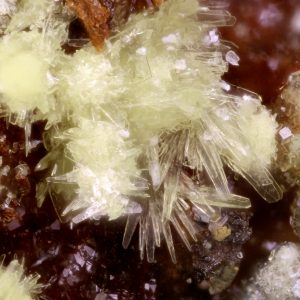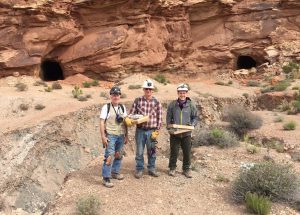Carbon Mineral Challenge Update: Most Structurally Complex Mineral Found
17 August 2016
Leószilárdite. Photo Travis Olds.
This summer the International Mineralogical Association’s Commission on New Minerals, Nomenclature and Classification approved two new carbon minerals, leószilárdite and ewingite. The new minerals were described by Travis Olds and colleagues, and bring the total number of new carbon minerals found since the launch of the Carbon Mineral Challenge in December 2015 to six.See the new minerals here.
Olds, who specializes in uranium chemistry and mineralogy, found the leószilárdite samples on a collecting trip to Red Canyon in Utah.

Tony Kampf, Joe Marty, and Travis Olds at the mouth of the Giveaway-Simplot mine in Red Canyon. Photo Tony Kampf. Click to enlarge.
“I met Joe Marty at the 2015 Tucson show and bugged him to send some of the new Red Canyon, UT uranium sulfate samples, which he kindly sent,” said Olds. “After a while we set up a collecting trip together later that year, and that’s when we found the leószilárdite specimens. At the time we were just happy to have collected some excellent andersonite, and it wasn’t until I got home with the specimens that I noticed the new mineral.”
Leószilárdite isn’t one of the uranyl carbonates predicted by Hazen and colleagues [1], and represents the first natural Na, Mg containing uranyl carbonate. However, like many of the new carbon minerals, it is rare, ephemeral, and water-soluble.
“Finding new minerals that don’t conform to our predictions is really exciting,” said Dan Hummer, Carbon Mineral Challenge PI. “By finding unexpected minerals we can refine and expand our models. It’s science in action!”

Ewingite. Photo Travis Olds.
The structure of ewingite came as an even greater surprise, when Olds et al. determined it is the most structurally complex known mineral on Earth. Ewingite is unique in that it contains the largest natural cluster yet found in a mineral (see video below). Jakub Plášil found the mineral in Plavno mine, Czech Republic, and there are only a handful of specimens in existence. Like leószilárdite, ewingite formed through the oxidation of uranium in the unique humid environment of the mine.
“Finding a mineral with this level of structural complexity is a real tour de force,” added Hummer. “I was thinking that ewingite had quite a massive formula, and now I can see why!”
Reference:
1. Hazen RM, Hummer DR, Hystad G, Downs RT, Golden JJ (2016) Carbon mineral ecology: Predicting the undiscovered minerals of carbon. American Mineralogist 101:889-906

